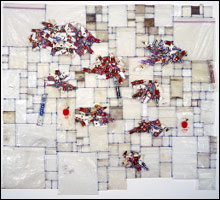
PHILLIE CLOUDS: What makes Fruin’s best pieces work is his mix of dazzling composition, sociological inquiry, and obsessive craftsmanship. |
Tom Fruin noticed the postage-stamp-sized plastic baggies in front of his apartment building not long after his move to New York’s Lower East Side, in 1996. The bags had packaged drugs, he realized, but back in Los Angeles, where he grew up, he’d never noticed bags of such colors and patterns and tiny size. They were secrets hidden in plain sight. “I was just wasting so much time looking at them that I started picking them up.”Over the following months, he collected dozens, and he pushed them around on a table in his Brooklyn studio, arranging them side by side, sliding them inside one another, certain he had to make something of them, but not sure what. Finally he struck on the idea of stitching them together like patchwork quilts.
At roughly 5-1/2 by 8-1/2 feet, Overview: Lillian Wald Houses (2005) is by far the grandest piece in his pocket-sized show at Judy Ann Goldman Fine Art. He made 30 to 40 hour-and-a-half visits, over six months, to the mostly black and Latino Lillian Wald housing project, about a mile from his apartment, combing the lawns to collect the 5000 or so baggies the composition required.

From across the gallery, Lillian Wald’s patchwork pattern shimmers, luring you in. You find pink, green, blue, red, and yellow baggies, glassine wrappers stamped “Good & Plenty.” There are bags decorated with marketing insignias: Batman logos, aliens, hearts, pot leaves, horses, dolphins, eight balls, chocolate kisses, Playboy bunnies, dollar signs, bombs, devil’s heads, Superman logos, ice-cream cones, skulls. Many bags are clear; some are muddy or hold the residue of heroin, cocaine, marijuana, crack. Fruin mixed in Phillies, White Owl, and Dutch Masters labels, trash from cigars he suspects were emptied of tobacco and filled with marijuana to make Phillie blunts.
His quilts often indicate the distribution patterns of drug refuse in specific housing projects or parks. He spent a month taping the Lillian Wald bags together in a pattern that approximates the scattering of bags across the housing project — browns, greens, and blues are clustered at bottom right, White Owl labels in the right center. “It’s like seeing some glimpse into a world you don’t know.”
He bound them with zigzag stitching, first as islands, then joining them together for the large quilt before carefully tweezing out the tape. The quilt is stiff and bulky to the touch, like a plastic tarp, but hung several inches out from the wall, it’s diaphanous, curling in the room’s air currents.
Nearby hangs Highbridge Heap (2006), a welcome-mat-sized flag of clear bags except for a smattering of cigar labels and colored bags grouped at the bottom that make evident the absence of labeling on the bags he found at Highbridge Park in Harlem. Phillie Clouds (2006) suggests clusters of brown cigar wrappers floating above a patchwork of property seen from the air.
Fruin contrasts the illicit thrills of drugs with the quilt as a symbol of wholesome Americana, security, and warmth. Eschewing for the most part bad-ass posturing and sentimentality, he documents the way his anonymous neighbors seek the rush or the relief of intoxication as they try to escape this life for a while and maybe tempt self-destruction. What makes his best pieces work is his mix of dazzling composition, sociological inquiry, and obsessive craftsmanship in rebellion against our increasingly plastic world.
A number of artists these days are making what you might call sciency abstraction, graphing and mapping, their work inspired by science but usually not quite science. Abstraction came to seem egotistically melodramatic or hollowly formal at the end of modernism, so they aim to ground it in worldly data. In Goldman’s back corner, Boston artist Sheila Gallagher presents drawings created by machines that recorded her eye movements as she scanned photos of female athletes. Here and there you can pick out the shape of Michelle Kwan or some tennis or gymnastics star, but often they’re overwhelmed by jagged scratchy webs of line.
In May, Goldman showed Cambridge artist Hannah Burr’s abstract concoctions of cards and ribbon, their compositions driven by quotidian observations Burr had charted according to a barely decipherable rubric. At MassArt’s MFA candidates exhibition in April, Nathalie Miebach exhibited an abstract sculpture of basketry and styrofoam balls that somehow graphed Antarctic tidal rhythms. Boston-born, Brooklyn-based Josiah McElheny showed a sculpture in New York in May that diagrammed the Big Bang while evoking the space-age chandeliers at the Metropolitan Opera House.
On a recent Tuesday, Fruin arrived via the Chinatown bus to hang his show. When I showed up, the shaggy-haired, easy-going 32-year-old white guy was working out the placement of his flags and quilts and unpacking a box of broken Jack Daniel’s whiskey bottles. A few years back, his quilts prompted him to begin “looking at what the larger meaning was of addiction and vices and repetition. I found them all to be pretty similar, all these drives that just function to complete themselves in a way.”